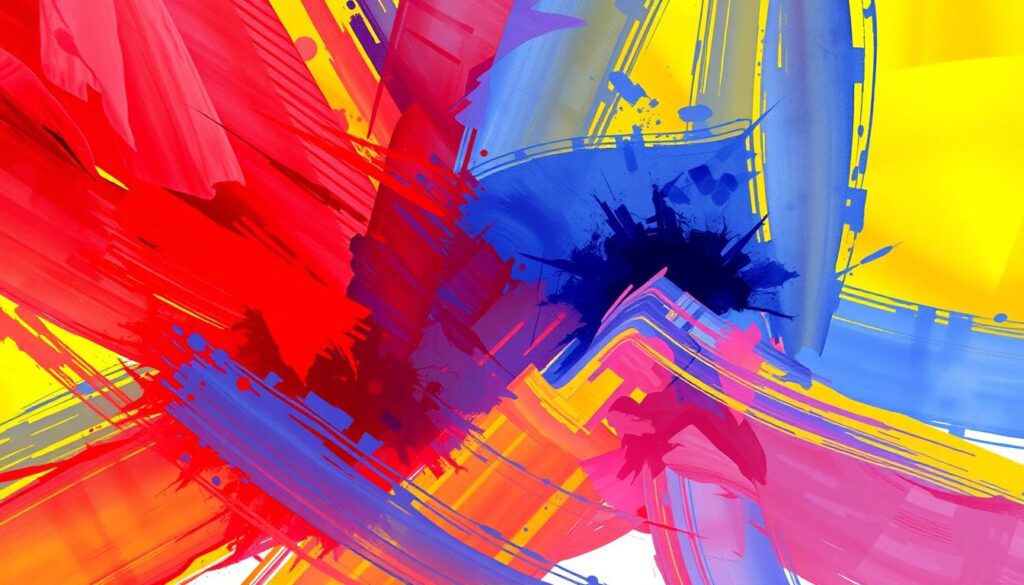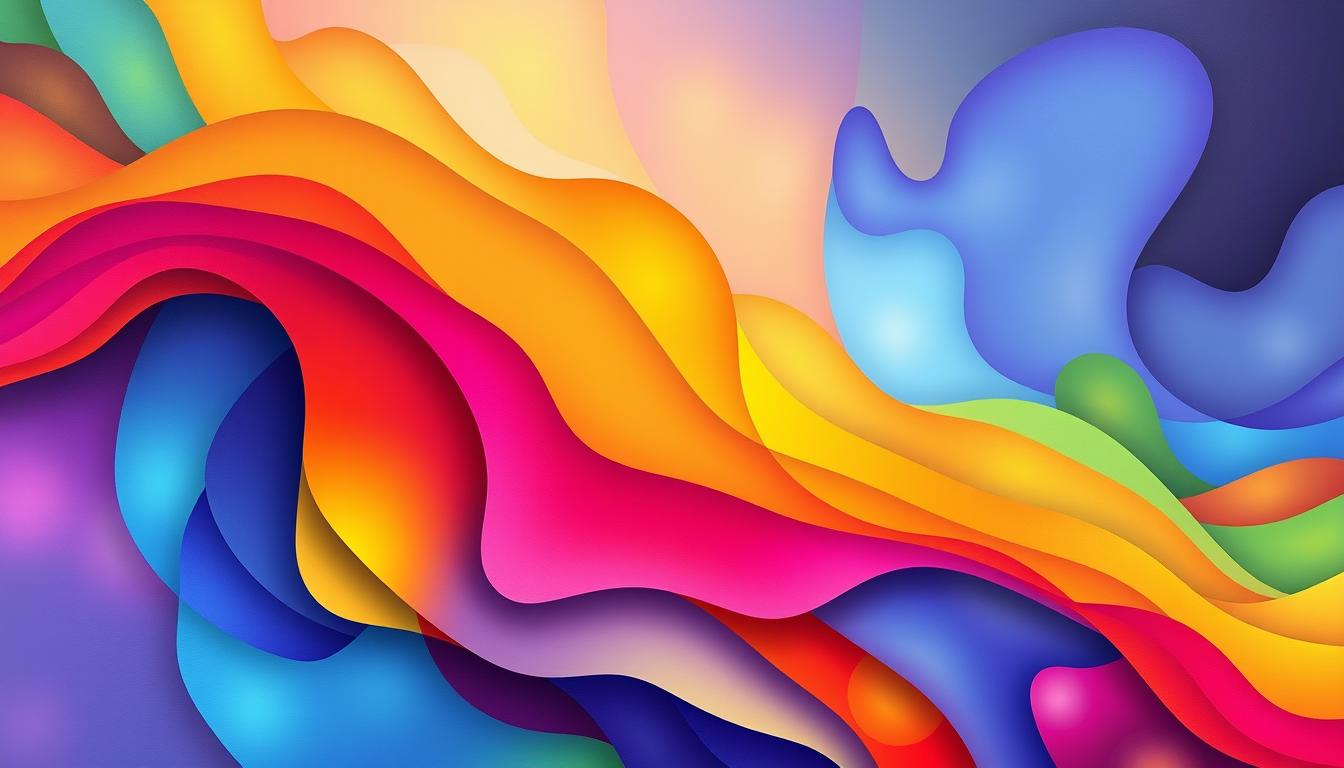Color is a powerful tool that shapes our perceptions, emotions, and decisions. Designers, marketers, and communicators need to understand color psychology. This knowledge helps create impactful experiences that connect with our audience.
Colors can evoke emotions, trigger psychological responses, and influence our buying decisions. By using this knowledge, we can make branding, design, and marketing more effective. Colors like blue calm us, while red energizes us. The psychology of colors is key in how we interact with the world.
In this guide, we’ll explore the science of color perception and color theory’s history. We’ll look at how color psychology is used in marketing and its impact on human behavior. We’ll also discuss the symbolic meanings of colors in different industries. By the end, you’ll know how to use color to engage your audience and achieve results.
Understanding the Fundamentals of Color Psychology
Color greatly influences our feelings, views, and choices. To fully use color’s power, we must grasp the science of color perception and color theory’s history. Let’s explore these key ideas that are the base of color psychology.
The Science Behind Color Perception
Seeing color is a mix of light’s physical traits and how our eyes and brain handle it. The color wheel and color relationships come from years of science and art. Knowing how we see color lets us discover the deeper meanings and feelings certain colors bring.
Historical Evolution of Color Theory
The study of color theory has a long history, starting with ancient thinkers and artists. From Sir Isaac Newton’s early work to Johannes Itten’s groundbreaking ideas, color theory’s growth has shaped our understanding and use of color. It impacts art, design, marketing, and psychology.
Basic Color Wheel and Relationships
The color wheel is key for seeing color connections. It shows primary, secondary, and tertiary colors, and color schemes like complementary and analogous. This knowledge helps us fully use color in our work and decisions.
Psychology of Colors, Emotional Design in Modern Marketing
In today’s fast-paced marketing world, using color marketing and emotional design is key to building brands and influencing people. We see how smart brands use color branding to make people feel certain ways. They aim to leave a mark and guide how people act through different marketing ways.
Colors can make us feel things, shape what we think, and even affect our choices without us realizing it. Brands that get color psychology can create eye-catching looks that really connect with their audience. By picking colors that match their brand’s vibe and the feelings they want to share, marketers can build loyalty and get people involved.
Colors play a big role in how we see and interact with brands, from packaging to digital stuff and in-store visits. By using colors that touch our emotions, companies can make unforgettable experiences. These experiences can create strong bonds with customers.
The art of emotional design keeps growing, making color use in marketing more complex and effective. By knowing the meanings behind different colors, brands can tell stories that speak to their audience. This shapes the future of color marketing.
The Impact of Colors on Human Behavior and Decision Making
Colors deeply affect our actions and choices. By knowing how different colors influence us, we can understand Color Emotions better. This knowledge helps us see how colors shape our feelings and decisions.
Neurological Responses to Different Colors
Studies in Behavioral Psychology show how colors affect us. Red makes our heart rate and blood pressure go up. On the other hand, blue and green calm us down. These changes can affect our mood, focus, and thinking.
Cultural Variations in Color Interpretation
Our culture shapes how we see colors. What one culture sees as good or bad, another might not. Knowing these differences is key for effective design, branding, and marketing. It helps us connect with our audience better.
Behavioral Changes Triggered by Color Exposure
Being around certain colors can change how we act. Yellow makes us hungry, while blue boosts creativity. Using this knowledge, businesses and designers can create spaces and experiences that get the right response from people.
Primary Colors and Their Psychological Effects
Exploring color psychology, we see how primary colors like red, blue, and yellow deeply affect us. These colors have a special power that designers and brands use to grab our attention.

Red is known for passion, energy, and urgency. It gets our senses going and makes us excited. That’s why it’s often used in branding and ads.
Blue is calming and trustworthy. It makes us feel stable and reliable. Yellow, the brightest, is full of optimism, creativity, and mental stimulation. It’s a key element in design and marketing.
Knowing how primary colors work lets us use them wisely. We can make our messages more emotional and engaging. By using these colors well, we can connect better with our audience and build strong brand loyalty.
Warm Colors: Triggering Emotions and Actions
In the world of color psychology, warm colors have a special power. They can make us feel strong emotions and change our actions. Let’s explore how Warm Colors affect our minds.
Red: Power, Energy, and Urgency
The bold Red grabs our attention. It’s linked to power, energy, and urgency. This color can make us feel hungry, raise our heart rate, and increase blood pressure.
Using Red in Emotional Design can make a brand exciting and full of life.
Yellow: Optimism and Mental Stimulation
Yellow is bright and uplifting. It brings Optimism and boosts our thinking. This color can make us feel happy and creative.
In design, Yellow adds warmth and positivity. It’s great for projects that want to lift our mood and improve focus.
Orange: Creativity and Enthusiasm
Orange mixes Red‘s energy with Yellow‘s optimism. It’s a vibrant color that sparks creativity and enthusiasm. This color encourages us to be adventurous and social.
Adding Orange to Emotional Design can make things feel exciting and full of life.
Cool Colors: Creating Calm and Trust
In the world of color psychology, cool colors are a true haven. Cool Colors, like blue, green, and purple, have a unique power. They soothe the senses and bring a deep sense of calm.

Blue, the quintessential cool color, brings feelings of serenity and stability. Its calming hues inspire confidence and trust. This makes it a favorite for corporate branding and healthcare.
Green, with its verdant shades, evokes growth, harmony, and environmental awareness. It’s perfect for wellness and sustainable brands.
Exploring Color Theory reveals the enchanting purple. It combines blue’s tranquility with red’s creativity. This results in a sophisticated, introspective color. It’s used in luxury packaging and spa settings to enhance the emotional experience.
Color Symbolism Across Different Industries
In marketing and branding, color is key. It shapes how people see and feel about products and services. We explore how different fields use Color Symbolism to send messages and stir emotions.
Healthcare and Wellness Sector
In healthcare and wellness, Color Branding is vital. It builds trust, shows professionalism, and brings calm. Blue and green, symbols of peace and nature, are common in hospitals and clinics. They aim to make patients feel safe and cared for.
Technology and Innovation
The tech world loves bold colors. They show Color Symbolism that matches their new products. Brands use blue, green, and purple to show they’re smart and ahead. This helps them stand out and attract tech fans.
Food and Beverage Industry
In food and drink, Industry-Specific Color Use is key. Warm colors like red, orange, and yellow make us hungry. Cool colors like blue and green suggest freshness and health. Using colors wisely can really sway what we choose to eat and drink.
Implementing Color Psychology in Brand Identity
In the world of branding, color psychology is key. It shapes a company’s look and connects with its audience. By picking colors that match the brand’s values, color branding can stir emotions and shape how people see the brand. We’ll look at how to use color to make a brand stand out and feel cohesive.
Choosing colors for a brand is a big deal. Each color has its own meaning and feelings, which must be thought about carefully. For example, tech companies might use blues and grays for reliability and innovation. Wellness brands might use green and brown for nature and tranquility.
Color psychology in branding is an art that needs finesse. The colors should show the brand’s heart and work well together. By thinking about how colors interact, we can make a color branding plan that makes the brand memorable.
Color Combinations and Their Emotional Impact
Designers use Color Combinations to deeply affect how we feel. From bright, contrasting colors to calming Analogous Color Harmony, colors can stir many emotions. They help set the mood for what we see.
Complementary Color Dynamics
Complementary colors, opposite each other on the Color Wheel, grab our attention. They bring energy and intensity. This mix can spark excitement and action in the viewer.
Analogous Color Harmony
Analogous Color Harmony uses colors next to each other on the wheel. It brings calm and balance. These colors are great for Emotional Design in places like healthcare or wellness.
Monochromatic Schemes
A Monochromatic design uses different shades of one color. It shows sophistication and elegance. This style is often seen in luxury brands and high-end designs.
Designers and marketers can use Color Combinations to create powerful experiences. By knowing how colors affect us, they can make designs that connect deeply with people. This leads to the right emotional responses and strong connections.
The Role of Context in Color Psychology
When we talk about Contextual Color Psychology, the setting around a color matters a lot. The Environmental Factors like lighting and other colors nearby greatly affect how we see and feel colors. This shows how important the surroundings are in color psychology.
For example, a blue shade can feel calm and peaceful in a natural setting. But, it might seem cold and distant in a simple office. This shows that colors can change their meaning based on where they are used.

Designers and marketers can use this knowledge to make better experiences. They can choose colors that fit the mood they want to create. Whether it’s a cozy café or a bright store display, the right color can make a big difference.
Conclusion
Exploring the psychology of colors has shown us how much they affect our feelings and choices. Different shades can trigger our brain’s responses and change how we see the world. This study is key to making designs that really connect with us.
Looking ahead, color theory will play a bigger role in marketing, branding, and design. By keeping up with new research, we can use colors to grab attention, stir emotions, and influence choices. This was once hard to imagine but is now possible.
Our journey through color psychology has been enlightening. We’re eager to see how it will keep changing our interactions with the world. The future is bright and colorful, full of endless possibilities.



